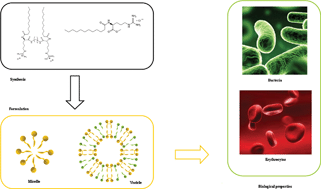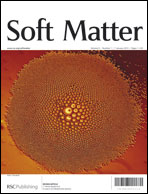Role of aggregate size in the hemolytic and antimicrobial activity of colloidal solutions based on single and gemini surfactants from arginine
Abstract
Cationic colloidal systems composed of arginine based surfactants (single or gemini structures) and membrane additive compounds such as DLPC or cholesterol have been characterized by means of size distribution and zeta-potential measurements. The single or monocatenary surfactant (LAM) as well as the gemini with the shortest spacer chain (C6(LA)2) formed micelles, while aqueous solutions of pure gemini surfactants with longer spacers (C9(LA)2 and C12(LA)2) formed very big aggregates. The addition of phospholipids or cholesterol changed drastically the aggregation behaviour. In the case of LAM and C6(LA)2, the incorporation of additives gave rise to the formation of cationic vesicles. For C9(LA)2 and C12(LA)2, this type of additives promoted the formation of smaller aggregates. All the formulations had positive zeta-potential values and in general exhibited high colloidal stability. We also evaluated the hemolysis and the antimicrobial activity of these systems. The capability of disrupting erythrocyte membranes depends on the hydrophobicity of the molecules and the size of aggregates in the solution. Gemini surfactants with short spacer chains are more hemolytic than their single chain homologue, while gemini surfactants with long spacers are much less hemolytic than their single chain counterpart. Moreover, for the same formulation, the hemolysis depends on the initial concentration of the stock solution used to set up the hemolysis/concentration curve. Results show that small aggregates interact easily with these biological membranes. The alkyl spacer chain and the presence of additives also play an important role in the antimicrobial activity, and, in general, the interaction with bacteria and erythrocytes is affected by the same parameters. The physico-chemical and biological characterization of these systems might be important for several biotechnological applications in which cationic vesicular systems are involved.


 Please wait while we load your content...
Please wait while we load your content...